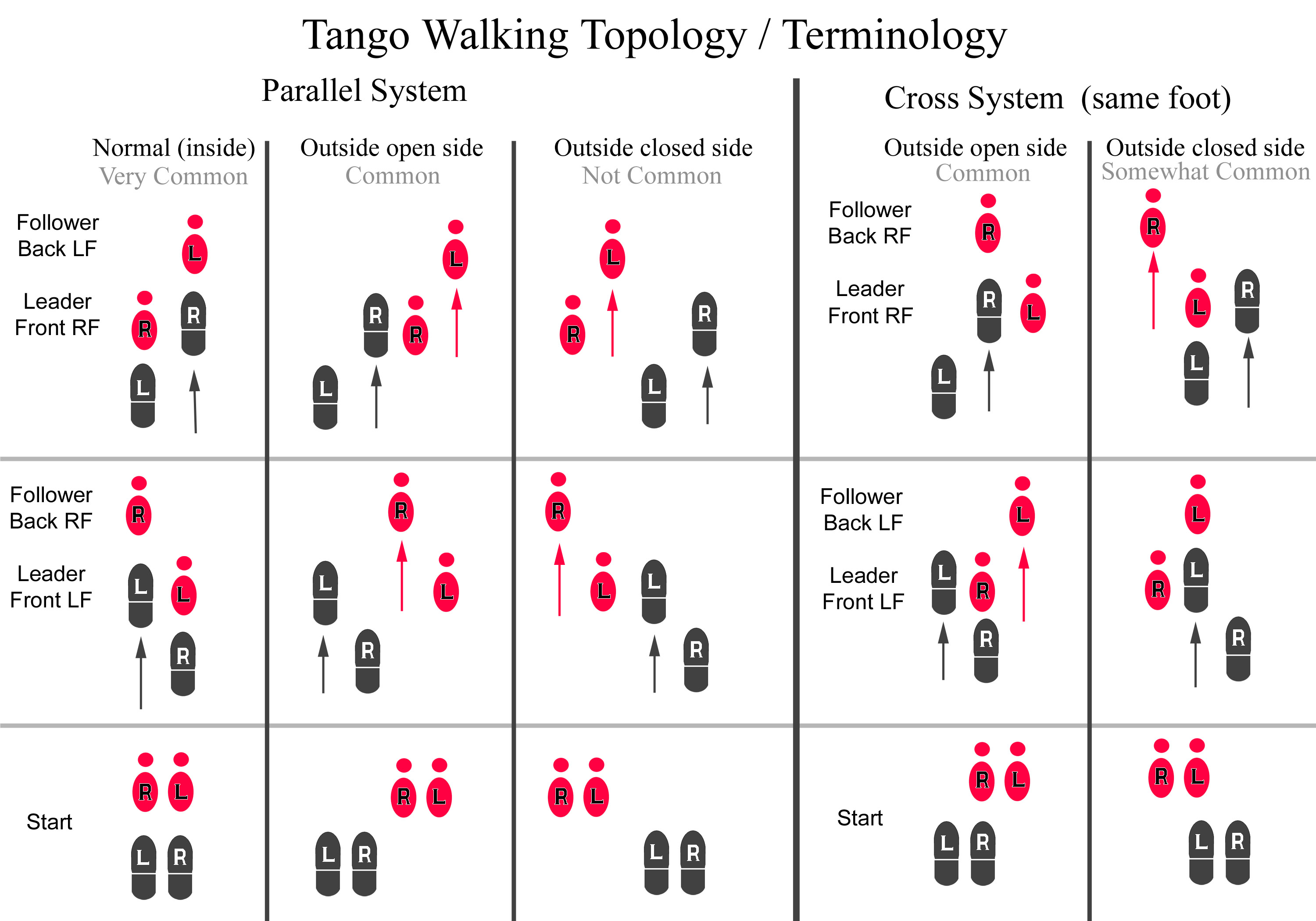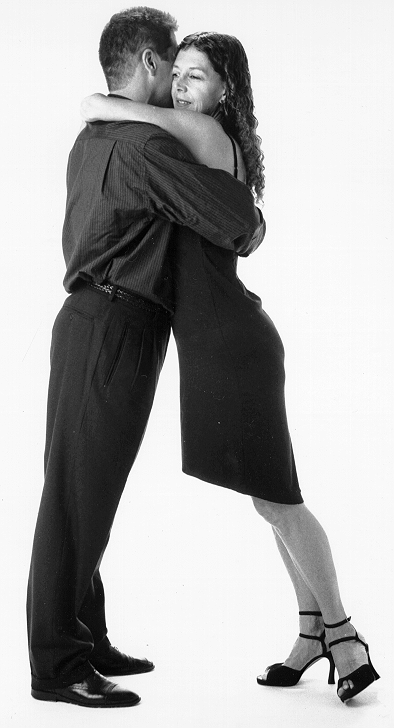Berkhamsted Class Notes, February 2012
These are the class notes for February 2012 Tango classes in Berkhamsted.
- 12th February: Crosses and Crossing
- 19th February: Dynamic ochos and sacadas
- 26th February: Close embrace and social dancing
12th February: Crosses and Crossing
Beginner class: cross-steps
We worked on changing tempos, using cross-steps walking forwards and backwards, separately then together.
Key points
- Take these steps without interrupting the general flow of movements - no hopscotch or "lifting"
- Keep moving in a straight line as much as possible - no zigzagging.
- Keep the crosses tight - back foot hooking close up to the front foot
- Followers, if your free leg is relaxed, this should happen naturally when led - you shouldn't really need to think about it.
We then worked on leading the follower into a cross step.
Key points
- When leading the actual cross, don't yank your partner to the side, simply straighten out your body - "close your chest"
- Followers: similarly, don't turn to the side, but keep facing your partner when you cross.
- Leaders: start "pre-leading" the cross on the step before the cross step itself.
- Followers: don't anticipate a cross after a certain number of steps back. Wait for it to be led.
Improver class: Cross steps for men
You don't always have to walk "mirrorred" (in parallel). There are several variations you can use.
2-track to 3-track walking:
The technique here is for the leaders to transfer weight, but without leading a transfer for the follower.
This involves moving between "2-track" (parallel) amd "3-track" (crossed) walking
We also briefly covered changes in tempo with the leader changing feet by himself (so going into "3 track" or "crossed" walking). We then worked on the men walking and adding in either back-cross steps, or changes of weight, so that leaders can lead a smooth change of weight (bouble time) as part of their movements; whilst keeping the followers moving backwards normally (single time).
Key points
- Leaders, keep the chest oriented toward the followers, not to the side. But keep your feet facing forwards; so dissociation again.
- Also, keep a steady sure lead - don't jump about and vary the pace, just because you're moving your feet in a different way.
- Followers, follow the lead from the chest, don't pay too much attention to what the leader does with his feet.
Potential movements with 2-track to 3-track walking
One nice movement which we can use this switch for is "travelling ochos" - that is back ochos with only a small degree of pivot, so that these are mostly travelling in the direction of the line of dance.
Leaders, you can get into these ocho movements with a change of weight, and similarly get out of them and back into parallel walking with another change of weight.
More information:
Finally, this diagram (hopefully) helps explain the "track concept":

19th February: Dynamic ochos and sacadas
Beginner class: Dynamic Ochos
We worked on leading and following simple forward ochos, working on leading with the chest (pivotting without stepping), and the followers walking "in a circle" around the leader (keeping the same distance from your partner at all times).
For followers: to expand on this a little, for a forward ocho, do not simply walk in a straight line, ending up further away from your partner - or, this is what not to do:

Instead, what you should do is to think of an ocho as being a step around your partner, in a circular manner. You're tracing the first part of a circle around your partner.
For example:

This means you'll be keeping yourself at the same distance from your partner at all times during the step.
We worked on an example sequence, to show how this might work:
- Leader pauses on the left foot, then pivots to the right (clockwise),
- Leader then opens out left side to lead partner to take a forward step to the leader's left
- Leader pivots to the left, follower pivots also.
- Leader then opens out right side to lead partner to take a forward step to the leader's right (back to original position)
- Leader then steps off on the right foot
- "Rinse and repeat"
Variations of this are also fine - for example, pausing on the right foot to start, then leading the partner to step to the right and so on.
Key points:
- Leaders: always lead the pivot first, then the step. Don't try to do both at the same time.
- Leaders: the step after the pivot is in the same direction as the pivot. Forward ochos are taken with the inside foot (the foot closest to the leader), back ochos with the outside foot (foot furthest from the leader).
- Followers: pivot first, then step. They are two separate motions - don't rush into one before the other.
- Followers: keep your chest facing towards your leader (that's the "dissociation" thing).
"Dynamism"
We then worked on making these ochos more "dynamic", by putting more energy into them - leaders applying more energy, and followers resisting that energy to elongate the movements.
We briefly worked on applying this energy to a pivot also, allowing the followers to use this energy to decorate their pivots with forward hooks (effectively, small forward boleos).
Improvers class: Sacadas
We then took these dynamic ochos, and applied a sacada as part of the movement, as follows:
- Lead the lady into a forward ocho to the man's right.
- Sacada the woman's back foot with the man's right foot, stepping forward onto that right foot.
- Over-pivot the woman clockwise, whilst pivotting yourself
- Lead her into a forward step to your left, whilst taking a sidestep to your left to match.
- And repeat.
Basically, from the woman's point of view, she's doing two forward ochos, one of which is overturned.
Key points
- Leaders, it's vital to step forward with "authority"; into the follower's body.
- Followers, dissociate with the ocho to allow the leaders to step forward.
- (Dissociation is key to a lot of the dramatic "shapes" - it's also the key to making effective pivot-based movements - that is, most Tango Nuevo movements)
More information:
26th February: Close embrace and social dancing
Beginner class: Close embrace and the walk

We spent some time working on the close embrace, ensuring that we could establish a good, clear and close connection with our partner.
The main concept of this is to focus on the key point that the connection is the most fundamental aspect of the dance - and that the closeness of the embrace is not something to avoid, it's something to, well, embrace...
The sequence of events for taking any step is:
- The leader signals his intention by moving his chest (centre) in the direction he wants the follower to go - for example, forwards
- The follower extends/moves her free foot in that direction - for example, back
- The leader starts his step, extending his leg into the space that the follower has made available
- Leader and follower both then transfer their weight onto the extendeded leg
Key points:
- Don't hold back, but wrap yourselves into the embrace. Don't "pull" your partner in to the embrace, but "push" against them
- Walk smoothly - don't stop and start
- Keep level when walking - don't bob up and down
- When you stop / start keep the feet together
- Weight is always on one foot or the other - not both
- Close embrace dancing is all about variations of simple steps, not about complex movements
- Leaders: provide a stable and secure embrace for your follower. Don't rush off too early
Improvers class: Close embrace movements and social dancing
We looked at travelling back ochos - the same pattern we examined a couple of weeks ago - but this time in a close embrace.
We then looked at some "Dos and don'ts" list for social dancing:
Advice for leaders:
- Obey the line of dance (don't overtake, it's not a race)
- Ask for dances courteously.
- Above all else, protect your partner.
Advice for followers:
- Be careful with your heels, they can be dangerous weapons.
- Accept or reject dances courteously.
Advice for all:
- Remember the "3-dance" rule - "tandas" are groups of dances separated by interlude music ("Cortinas").
- "Thank you" means "Goodbye".
- Respect the other dancers on the floor.
More information: